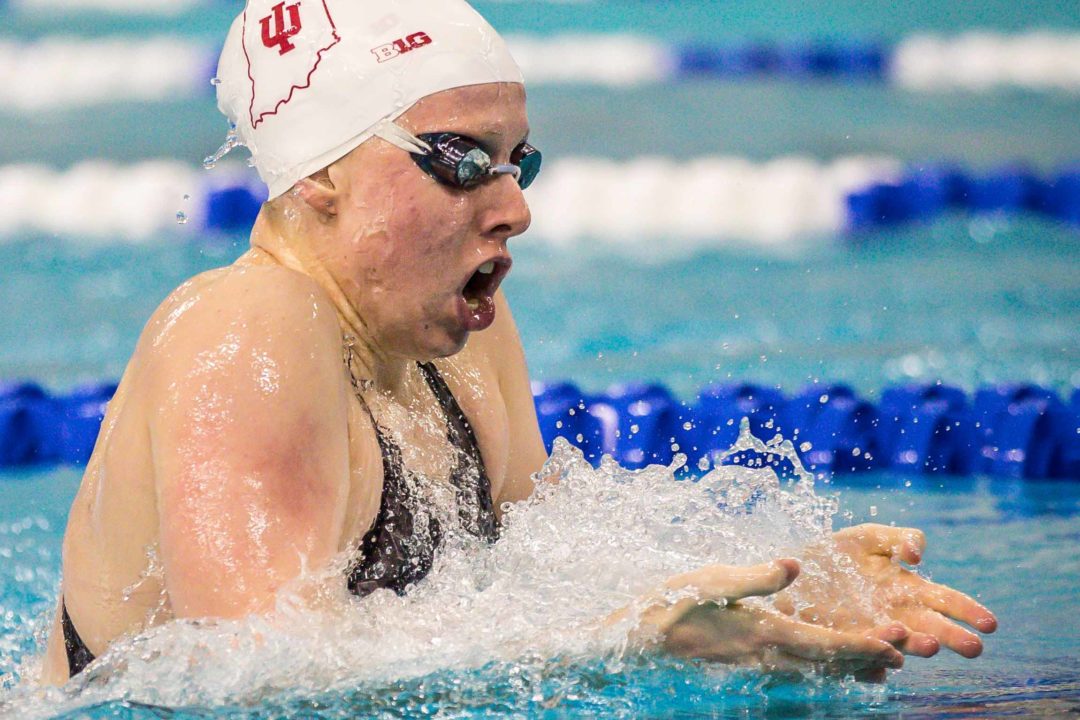TritonWear and SwimSwam bring you the best in swimming race analysis. With the power of TritonWear, you can access 12+ metrics for all athletes simultaneously, display the results in real-time to unlimited screens on deck, and review later in an easy to use interface for monitoring progress and identifying trends over time.
The women’s 100y breaststroke at the 2019 NCAA DI finals delivered an exciting race, as defending champion Lilly King broke her own NCAA and American record. Top breaststroker performers Lindsey Kozelsky and Sophie Hansson also graced the field, along with Delaney Duncan, who earned her spot in the top 10 fastest performers with this race.
King shot off to an incredibly fast start, leading the field by at least four tenths of a second in the first 25. She continued to generate the fastest speed throughout the race, widening her gap off every turn.
Though she swam the fastest speed in every lap, King only registered the highest stroke index (Speed x DPS) in the final lap. Her breaststroke efficiency in each lap was right around the average of the heat, opting to go for a faster stroke rate than high stroke efficiency for majority of the race.
While she stroked at a fast rate, her DPS did not drop off in any way, and this was key to her fast speed. She consistently supplemented her fast stroke rate with a moderately high DPS, giving her a great lead with each stroke.
Duncan, who finished next to King, also employed a fast stroke rate for most of the race. Interestingly, Duncan went from pulling with the slowest stroke rate and highest DPS in the 1st lap, to producing the fastest stroke rate with the shortest DPS in all subsequent laps.
Throughout the race, Duncan, Hansson, and Kozelsky were in a close match for podium finish, alternating leads in each lap. Kozelsky and Hansson both took longer strokes, with Hansson logging fairly consistent stroke rate and DPS for most of the race. Kozelsky’s stroke rate, however, tapered off after the halfway point while still pulling at nearly identical DPS as Hansson, giving Hansson the opening to take the lead in the back half of the race.
Meanwhile, Duncan was trailing behind Hansson and Kozelsky as they hit the 75y mark. But, with a fast turn heading into the final 25, she sped up her stroke rate even more, overtaking both Hansson and Kozelsky to win silver.
This race highlights the key role a fast stroke rate plays in sprint events, and the importance of balancing it out with high enough DPS. King and Duncan, the top 2 finishers, had the fastest stroke rates in their heat. One difference in their stroking was King’s ability to hold a higher DPS at her stroke rate, combining good quality strokes with fast stroke turnovers, ultimately leading a 100y race by over 2 seconds.
VISIT THE TRITONWEAR HQ
LIKE TRITONWEAR ON FACEBOOK
FOLLOW TRITONWEAR ON TWITTER
FOLLOW TRITONWEAR ON INSTAGRAM
Swimming analysis is courtesy of Tritonwear, a SwimSwam partner.


One last thing, in spite of my criticism below, I think Triton Wear is a great product and providing extremely valuable information to swimmers, coaches and parents. I am a stickler for accuracy.
One other thing is that in your data, you refer to the Cycle Time as SR, which is confusing. Many coaches do the same. It is easy to convert one to the other, but should be called what they are.
DPS does not win races. Sustained speed does. The stroke index places too much importance on DPS and, as Lily shows, DPS is not going to do the trick in winning shorter breaststroke races (or any other short race). Speed is DPS x Stroke Rate. They each count, but equally. The SI, which is DPS x DPS x SR, in my opinion, should not be used to judge swimmers.
Very interesting